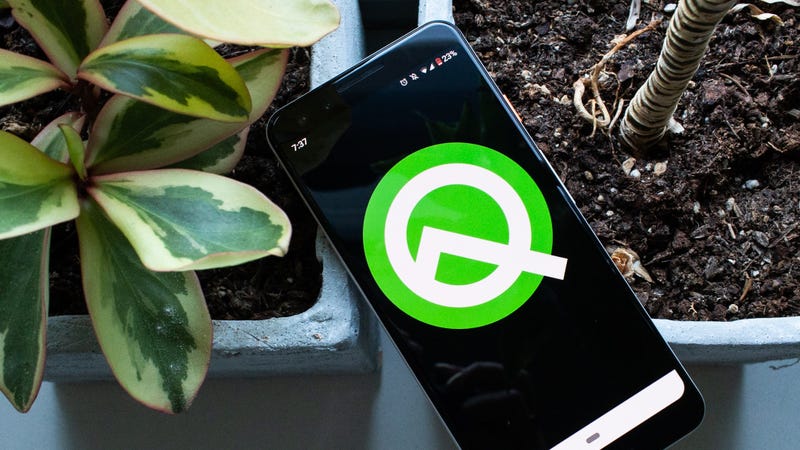
Google’s next version of its mobile operating system, Android Q, isn’t quite ready for prime time just yet. For the brave few who don’t mind encountering a bug or two, you can download the third beta of Android Q and try it out on your Android phone before it’s available to everyone else.
But for those who are comfortable waiting until the software is ready to release, keep reading. Google announced more features for Android Q at its annual developer’s conference this week. From more robust security settings to improved Digital Wellbeing features, there’s a lot to look forward to from Google’s next major platform release.
5G connectivity
The world is already in 5G hype mode, and even though it’s not available everywhere yet, there’s enough buzz that companies and manufacturers have started future-proofing software and devices for its impending arrival.
Advertisement
For its part, Google bundled in 5G compatibility in Android Q. Once you have this version of the mobile operating system, you’ll be able to connect to your carrier’s available 5G network provided your phone is outfitted with the necessary components.
Fit for foldables
Foldable smartphones may not seem like a thing right now, especially after the folly of the Samsung Galaxy Fold. But the next version of Android will be optimized to work with these next-generation devices. Some of the new features include app continuity, which lets you launch an app on the main screen then flip it open to continue what you were about to do, along with some better multitasking abilities that allow multiple apps to be paused and resumed at once.
Advertisement
Smarter replies

If you’re on version Android 8.0 or later, you’ve already experienced the practical utility of Smart Reply. This feature offers reply suggestions in the notification shade when you receive a message.
Advertisement
Once Android Q goes live, the Smart Reply feature will be able to predict what you should do next. For example, if someone sends you a message with an address or the name of a restaurant, Smart Reply will offer a link to the Google Maps app to help you start navigating to that exact locale. It’s an easy way to move forward without having to copy and paste addresses, then tap around the screen looking for the next app you want to use.
Robust security and privacy controls

Advertisement
Google claimed that nearly 50 features are coming to Android Q related to security and privacy. We won’t know the extent of those changes until Android Q goes live to everyone. However, Google hinted at some of the options you’ll be able to access in the Android settings panel, including a new front-and-center Privacy section, with a bevy of settings for controlling which apps and services have access to your data. There will also be a new Permissions option that will let you choose how and when data and other elements are shared with Google and other third-party apps.
Small, timely updates
The problem: When Google needs to make a minor update to the Android operating system, it’s not always easy to push it out to the masses. The solution? Project Mainline, a new initiative from Google to push out security patches to more phones by distributing updates directly through the Google Play Store—where you already get your app updates. Project Mainline will be limited in what it updates, but it’ll include things like network permissions, time zone data, and media codecs.
Advertisement
‘Focus mode’ to limit notifications
Are you feeling unable to focus with your smartphone going off all the time? Android Q’s Focus mode, part of Digital Wellbeing, lets you select the apps you find most distracting—messaging apps, news apps, apps constantly pinging you about daily deals—and silences them until you decide that you’re ready to deal. You’ll be able to choose which apps and which folks are allowed through when you’re trying to concentrate.
Advertisement
Alternatively, Focus mode works even when you’re not trying to focus, like when you’d rather zone out on a Netflix binge. The idea is to keep work and play separate so that when you’re avoiding your phone, you’re doing so altogether. And when you’re dodging work, you’re fully ensconced in what’s going on rather than who is notifying you in Slack.
Built-in parental controls

Advertisement
Family Link will no longer be another app for parents to grab from the Play Store. Instead, it’ll come standard with Android Q and will be available to customize inside the device settings. It will offer better controls for parents hoping to cut down on kids with a tendency towards rampant screen time. Starting with Android Q, you’ll be able to set up specific time limits for those apps your kid is too obsessed with to finish homework, along with “bonus time” for when you’re feeling lenient.
Hey Google, let’s drive

Advertisement
Android Auto and Android embedded into the car are getting a big makeover this summer. But perhaps the most significant will be the version of Android Auto on the phone, which will no longer be a separate app. Instead, you’ll have to invoke it through the Google Assistant, so you can say something like, “Hey Google, let’s drive” to pop up the new optimized driving mode. The new driving mode features a slicker interface, with all the information you need within a short scroll rather than hidden behind another menu.
Find something to eat
Google Lens isn’t entirely specific to Android Q, though it is a part of the Pixel’s camera app. A new feature coming up the pipeline will help you do things like figure out what to eat at a new restaurant, without having to ask anyone, “What’s good here?”. With the help of Google Lens, you’ll be able to snap a photo of a physical menu, and Google will highlight the most popular items at that particular locale based on its reviews database. Google Lens will also be able to split a bill or calculate a tip after you snap a photo of the receipt and read signs and other text for people who can’t read the printed language.
Advertisement

Live captions
One of the most compelling features in Android Q will make audio and video available for the hard of hearing. Live Captions will enable real-time transcriptions of what’s being said on screen, regardless of the app you’re using. Folks hoping to catch something a podcast host said can use the feature for clarification on a line, while folks who are hard of hearing can use Live Captions to transcribe personal videos. Best of all, an internet connection isn’t necessary to use this feature, as the transcription is processed all locally on the device rather than through the cloud.
Advertisement
Gestures you can use

Gestures are controversial on the smartphone circuit because users don’t always appreciate them. But with phones getting bigger, and adopting edge-to-edge displays, the concept of using a gesture to navigate the operating system seems like the obvious evolution. Google first introduced gestures in Android Pie, and in Android Q they’ll be more refined. Rather than the standard three- or two-button layout features in the navigation bar, you’ll use a swipe up gesture to go to the Home screen, then swipe up and drag across to switch into multitasking view. And rather than tap a button to go back a page, you can swipe across the screen to switch between apps, then swipe up from the Home screen to reveal the application drawer.
Advertisement
Darkness, everywhere

Advertisement
If you’ve ever looked at your phone in the dead of night and thought to yourself, “dang, this is way too bright” you’re likely to be very enticed by this next new feature. Dark Mode has long been a coveted feature on the Android operating system, and now it’s coming system-wide, with dark themes available for every one of Google’s core apps. Third-party apps will have to implement it manually.
Dark mode is also helpful for saving battery life, particularly for those devices sporting bright OLED displays. Activating it pretty easy: pull down the Quick Settings menu, then tap the setting to switch over the interface from white to black.
https://lifehacker.com/the-best-new-features-in-android-q-1834620582
2019-05-09 14:00:00Z
52780284024875


/cdn.vox-cdn.com/uploads/chorus_image/image/63759979/jkastrenakes_08242017_1960_0019.0.jpg)
:no_upscale()/cdn.vox-cdn.com/uploads/chorus_asset/file/8603445/vpavic_170518_1705_0070.0.jpg)
:no_upscale()/cdn.vox-cdn.com/uploads/chorus_asset/file/12794165/dseifert_180905_2925_9843.jpg)
:no_upscale()/cdn.vox-cdn.com/uploads/chorus_asset/file/13299529/dseifert_181018_3039_1199.jpg)

:no_upscale()/cdn.vox-cdn.com/uploads/chorus_asset/file/16223199/google_gender_fluid_emoji_3.jpg)
